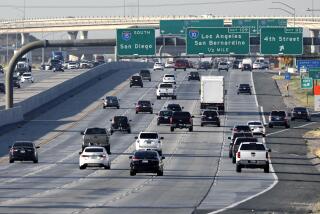Solo drivers of low-emission autos fume over fees to use carpool lanes
Drivers of electric and other alternative-fuel vehicles enjoy a special perk: They can drive solo in California’s carpool lanes.
But under a controversial plan proposed by local traffic agencies, those drivers will have to pay to use two heavily used carpool lanes that are being converted to toll roads.
It has riled electric-car shoppers and alternative-fuel-vehicle advocates who worry that this is the first step in chipping away at a California tradition of letting solo drivers of autos with new technology and low emissions onto carpool lanes.
“There is a real risk that if they do it here, they might try to do it elsewhere,” said state Sen. Alan Lowenthal (D-Long Beach.)
Officials plan to convert 25 miles of carpool lanes on the 10 and 110 freeways into toll lanes. Carpoolers and buses will be able to use the lanes for free, while solo drivers — even those in cars that could travel in regular high-occupancy-vehicle lanes without restriction — will have to pay up to $1.40 a mile during peak rush-hour traffic.
The special toll lanes will be part of a one-year pilot program on the 10 between Alameda Street and the 605 Freeway and on the 110 between Adams Boulevard and the Artesia Transit Center.
The Metropolitan Transportation Authority said it wants to keep traffic moving by charging all solo drivers for using the roads.
Solo drivers in cars with carpool-lane permits clog up traffic more than many people realize, said Stephanie Wiggins, an MTA official.
She said the agency looked at the effect of allowing conventional hybrids, such as the Toyota Prius, into the lanes in previous years. (Hybrids lost that access this year.) Wiggins said that on the southbound 110 during afternoon rush hour, hybrids and natural gas vehicles accounted for almost 1 in 5 vehicles in the carpool lane.
Lowenthal said he was surprised by the MTA move. Legislation that approved the demonstration project did not specifically require the agency to waive tolls for solo drivers of alternative-fuel vehicles because lawmakers didn’t anticipate MTA changing the rules for those corridors, he said.
The plan is making some car shoppers angry.
Attorney Mark Loza considered buying an electric vehicle but decided not to after learning that the car would not have free privileges to travel in the carpool lanes of the two freeways, including a stretch of the 10 he drives several times a week.
“This is a huge disincentive for hundreds of thousands of people who travel those routes into the most congested city in America,” the Rancho Cucamonga resident said.
Giving super-clean cars access to the HOV lanes is an effective and popular incentive, said John Boesel, chief executive of Calstart, a clean-transportation technology trade group in Pasadena.
“It’s disappointing that a portion of the HOV-lane network might not be available for the advanced vehicles. This will cause confusion and decrease the incentive to buy such cars,” Boesel said.
In London, which has pioneered such “congestion pricing” efforts, drivers of clean-fuel vehicles pay nothing or deeply discounted rates to use carpool lanes, and that is driving the purchase of electric and other clean fuel vehicles in that city, he said.
And toll bridges in the San Francisco Bay Area also give electric and natural-gas vehicles the same discounted rates as carpools during peak hours.
The MTA estimates that 5,000 to 7,500 people a day will use the 10 and 110 toll lanes, which are projected to generate $20 million in revenue during the pilot year.
Construction on the $210.6-million project, funded by a federal grant, started in July. The 110 portion is expected to be completed by end of 2012, while the section along the 10 will open in 2013, MTA spokesman Rick Jager said.
Tolls will vary from 25 cents to $1.40 a mile depending on traffic — the more traffic, the higher the price will be to keep added cars from clogging the lanes. If the speed of traffic falls below 45 mph for more than 10 minutes, the lanes will be closed to all solo drivers until speeds increase.
At the maximum rate, drivers could pay almost $20 to drive the 14-mile toll lane on the 10, but the MTA estimates that the average user will pay $6 per trip on 11 miles of the 10 and $4 per trip on the 110 during peak times.
More to Read
Inside the business of entertainment
The Wide Shot brings you news, analysis and insights on everything from streaming wars to production — and what it all means for the future.
You may occasionally receive promotional content from the Los Angeles Times.











